Ayodhya’s Ram Temple: A Journey from Myth to Marvel
-
Kumar Abhishek Anand
- January 29, 2024

November 9, 2019, marked a pivotal moment in India’s history – the Supreme Court’s historic verdict, clearing the path for constructing Ayodhya’s Ram Temple. The groundwork began with a ‘Bhoomi Pooja’ in August 2020, a ceremonial ritual to bless the construction site.
This blog post traces the remarkable journey of the Ayodhya Ram Temple from a court order to its majestic rise on sacred ground, detailing the phases of its construction and the intricate planning that brought this architectural marvel to life.

Table of Contents
ToggleAyodhya’s Ram Temple: Construction
The temple’s construction, overseen by the Shri Ram Janmabhoomi Teerth Kshetra Trust and executed by Larsen & Toubro, one of India’s largest construction firms, was a testament to India’s engineering prowess and dedication.

Construction Materials Used
Bansi Paharpur Sandstone: Approximately 600,000 cubic feet of this pink sandstone from Rajasthan was used. This stone is quite durable and aesthetic in nature.

Copper Plates: To avoid using iron, which corrodes over time, the construction used around 10,000 copper plates. Artisans used these plates to fuse the stone blocks, employing a traditional technique from ancient Indian architecture.
Bricks: Over 200,000 bricks, etched with ‘Sri Rama’, arrived from various parts of the world. These bricks have a symbolic and structural role in the temple’s foundation.
Pillars and Carvings: The temple houses 390 pillars, including 6 Makrana marble pillars on each floor. These pillars are intricately carved with over 10,000 sculptures and motifs, depicting various themes and deities from Hindu mythology.
Foundation and Durability

Seismic Resilience: Considering its location in Seismic Zone 4, engineers have engineered the foundation and structure of Ayodhya’s Ram Temple to resist earthquakes.
Metal-Free Foundation: The foundation layers were constructed without metal to prevent corrosion. This approach was a collaboration with IIT Madras and involved innovative engineering techniques.
Ayodhya’s Ram Temple Engineering

Style: The temple is designed in the Nagara style, a classical style of Hindu temple architecture prevalent in Northern India. This style has a shikhara(spire) that looks like a beehive.
Collaborative Effort: Besides L&T, the project received technical support from various institutes and organisations. The Central Building Research Institute, the National Geophysical Research Institute, and several IITs contributed in areas like soil testing and construction techniques.
ISRO’s Role: The Indian Space Research Organisation (ISRO) played a role in identifying an underground stream of the Sarayu river beneath the temple, showcasing the blend of traditional beliefs and modern science.
Economic and Social Transformation
The construction of the Ayodhya’s Ram Temple has catalysed a transformative economic upsurge in Ayodhya. Local businesses are thriving due to the increased influx of pilgrims and tourists. The district is witnessing a flurry of infrastructural developments, including the construction of an airport and the improvement of transportation facilities.
This economic revival is not just about numbers; it’s about the rejuvenation of a city and the empowerment of its people.
Conclusion
Ayodhya Ram Temple’s construction is not only a testament to religious sentiment but also showcases India’s architectural heritage and modern engineering prowess. Furthermore, the structure stands as a symbol of India’s rich cultural tapestry. The structure stands as a symbol of India’s rich cultural tapestry. It represents the country’s journey towards being a confluence of tradition and modernity.

This project shows a deep understanding of ancient construction methods. By skillfully integrating these methods with contemporary technology, experts ensure the creation of a lasting legacy.
Share
Kumar is a digital content professional with more than 2 years of experience in Blog writing, copywriting and scripting. His passion lies in the art of creating convincing content that plays a major role in converting leads for SAAS businesses.












